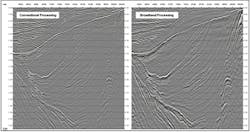Processing-based broadband enhances image quality in frontier areas
Allan Willis
Sean Poche
Tomislav Degel
Richard Clarke
Spectrum Geo Inc.
In recent years, there has been a significant amount of research and development related to marine broadband technology, both to remove the effect of the marine ghosts (reflections from the sea surface), and to obtain a broader bandwidth of useable seismic frequencies (both low and high). These works are generally separated into acquisition and processing solutions.
The goal here is to examine a processing-based broadband solution that can help improve imaging in frontier regions or under-explored areas using conventional flat streamer acquisition configuration. The data examples cover acquisition in deepwater (offshore Brazil) and shallow water (offshore Croatia).
Ghost reflections
A well-known issue in conventional marine flat streamer data is the interference from the free-surface ghosts from both source and receiver sides. These ghost reflections interfere, either constructively or destructively, with primary reflections. They also distort the frequency by creating spectral notches and the phase spectrum of the recorded seismic data.
In general, the effect of the sea surface ghost on constant-depth towed streamer is greatly influenced by source and receiver depths as well as water velocity and sea state. Shallow towing depth will help to avoid the ghost notches by recovering higher frequencies but attenuate lower frequencies, while deep tow recording recovers low frequencies at the expenses of attenuating high frequencies.
Over the years, developments in broadband acquisition techniques (such as variable-depth or dual-sensor streamer) have addressed the notch issues. More recently, many processing-based methods have been introduced because broadband processing can be a cost-effective solution to remove the severe ghost notches, enhance the seismic resolution, and improve structural and stratigraphic images, especially for marine seismic data acquired using conventional flat streamer.
Broadband-processed data has marked benefits for imaging and seismic inversion as it outlines detailed high-resolution features of shallower traps as well as providing deeper penetration and significant improvement for imaging deeper targets.
De-ghosting
The ghost removal process used in Spectrum Geo’s broadband processing is a non-linear inversion process that adapts the least-squares minimization method, which is based on either minimum energy or minimum absolute amplitude. This method estimates both source and receiver ghost times, as well as the reflection coefficients at the air/water interface for both the source and receiver ghosts. The process derives a recursive filter which is then applied to the pre-processed seismic data to create a ghost-free data.
After proper de-ghosting, the amplitude spectrum of the resulting full-stack section should show improvement in recovering both the low frequencies and the notches that were weakened by the ghosts. However, the seismic spectrum may often have a linear decay or roll-off of amplitude in the high-frequency content, especially in the deep part of the section. The loss of higher frequencies is due to the earth’s absorption effect (known as “Q”) and can easily be recovered with the application of pre-stack amplitude-only Q-compensation.
Offshore Brazil
The first data example discussed here is located in the deep waters of the Sergipe basin on the northeast coast of Brazil. This area has been attracting much attention since Petrobras drilled the successful Barra well in 2010, and the subsequent Barra-1 appraisal well. Other discoveries in the deepwater area of the basin include the Muriu and Farfan finds, which are in the turbidite channel systems of Mid- to Late- Cretaceous and Early Tertiary age. Stratigraphic hydrocarbon plays such as channel-fill sediment, rifted basin fill, and faulted Paleozoic sediment are key to exploration opportunities in this area. Therefore, improved identification and mapping of these potential reservoirs is essential.
In 2014, a deep-towed 2D dataset was acquired with a flat streamer and a single air-gun source at depths of 15 m (49 ft) and 10 m (32 ft), respectively. The result from the final pre-stack time migrated stack with broadband processing showed a significant uplift in the low frequency content and temporal resolution.
Offshore Croatia
This second data example is from the shallow-water area in the Croatian Adriatic Sea. The Adriatic offshore hydrocarbon province lies below the shallow waters between Italy and Croatia on the northern margin of the Mediterranean Sea. The Italian Adriatic is relatively well-explored while the eastern Croatian margin remains comparatively untouched. Despite the generic similarities, the nature of the carbonate oil play offshore Croatia is significantly different from that on the Italian margin. Therefore, high-quality seismic is required to successfully image the Triassic and delineate source kitchens, identify platform margin reservoirs, and support basin modeling to constrain the timing of charge.
A shallow-towed 2D dataset was acquired in 2013 with a flat streamer and a single air-gun source at depths of 8 m (26 ft) and 6 m (20 ft)respectively. After broadband processing, interpretable low-frequency signal was made available, providing strong discrimination of layers and highlighting subtle features, and subsequently enhancing interpretation across faults and other major structural features as well as improved quantitative inversion.
Conclusions
In recent years, the exploration focus has shifted to stratigraphic and deeper plays, especially in frontier and under-explored areas, and the demand for broadband seismic data has also increased accordingly. In conventional marine streamer acquisition, the reflections from the sea surface can strongly impact the seismic frequencies and bandwidth of the recorded data that is directly related to both source and streamer depths. Traditional processing works well only at frequencies below the first ghost notch. De-ghosting, followed by pre-stack application of appropriate inverse-Q filtering, can remove this limitation and recover lost bandwidth to produce a broader and balanced spectrum, thereby improving the resolution and interpretability of the seismic section.
Broadband data processing has been a hot topic for the last few years. Its value is evident from these two data examples, with improved resolution and bandwidth providing stronger discrimination of seismic events, as well as clearer imaging of deep targets resulting mainly from the increased low-frequency content.



